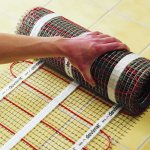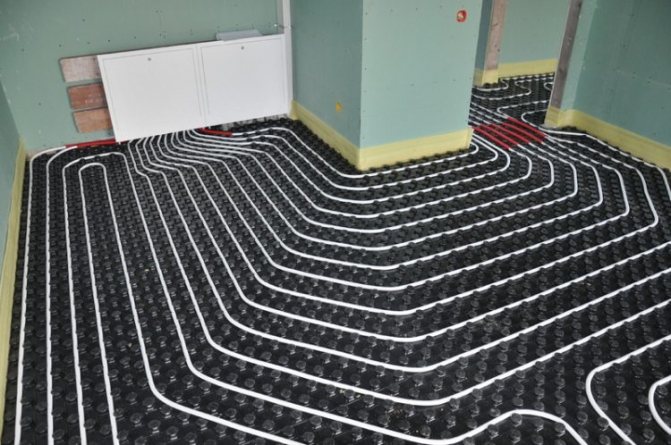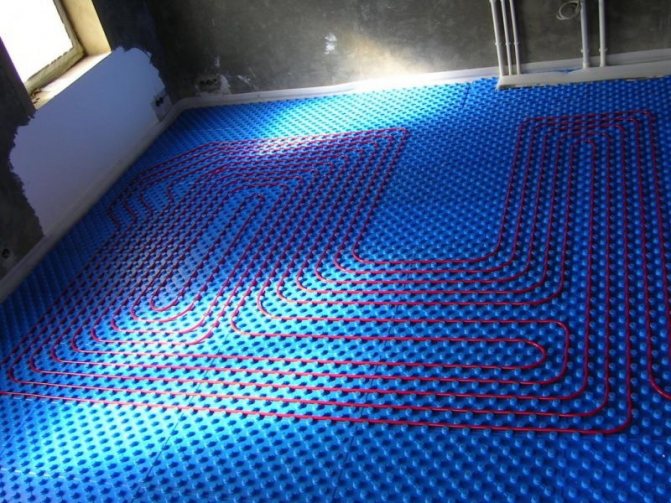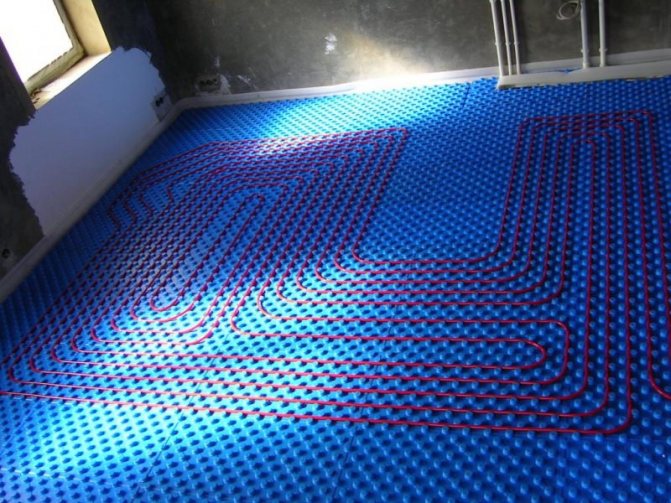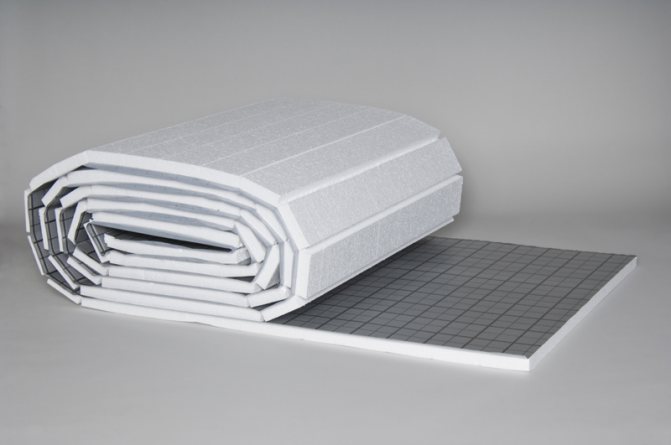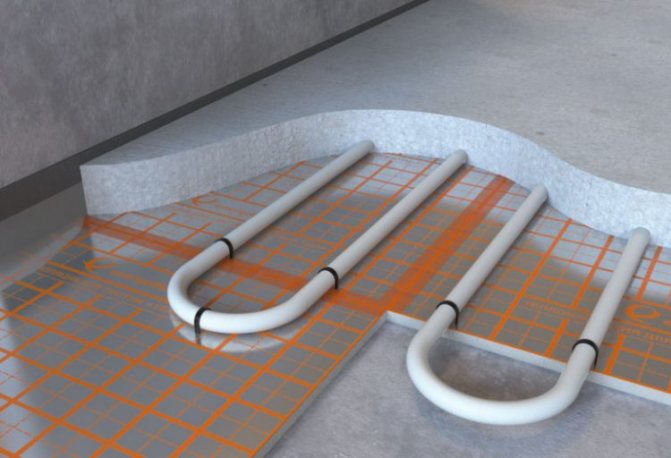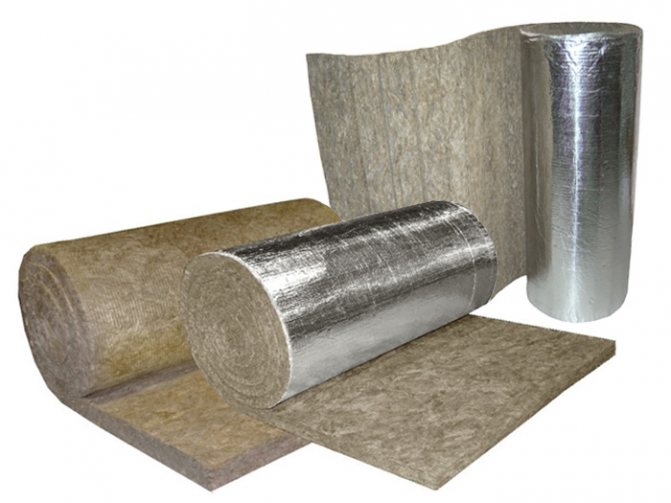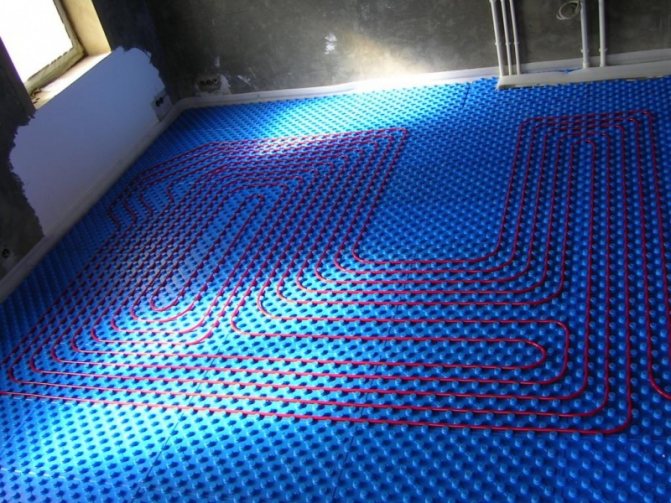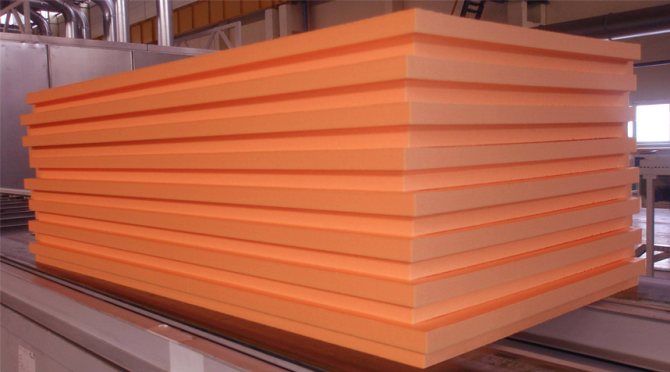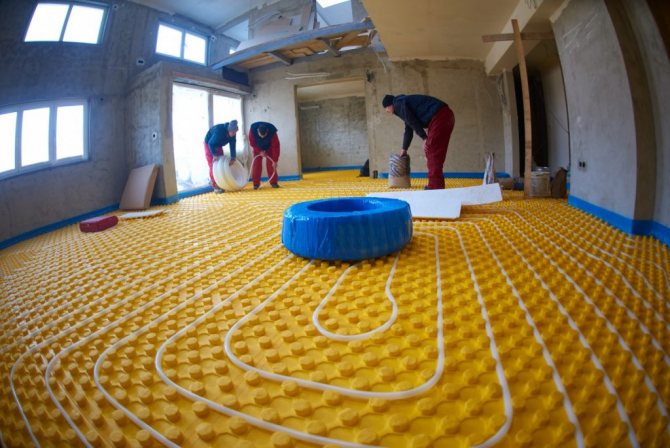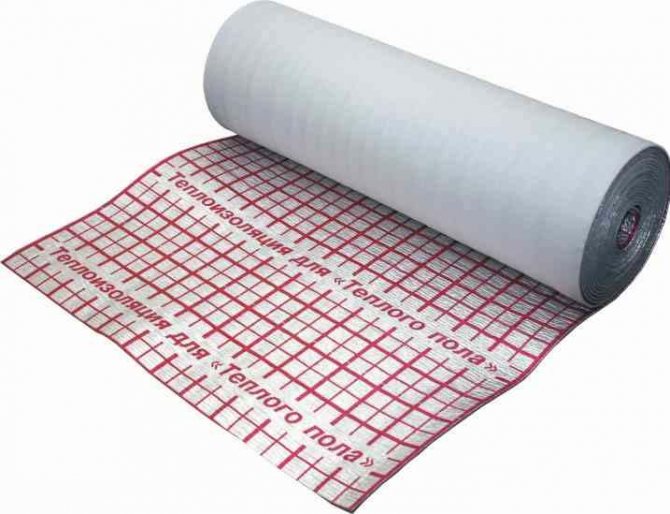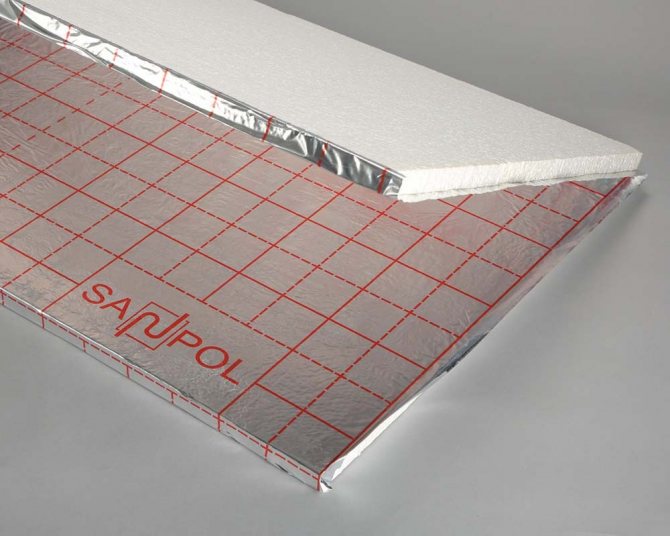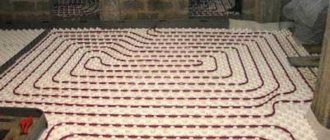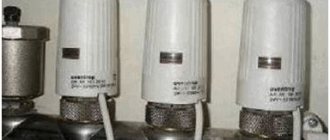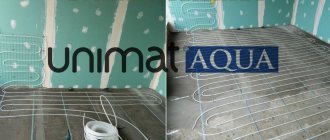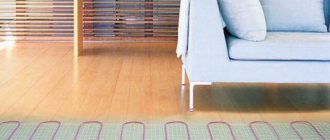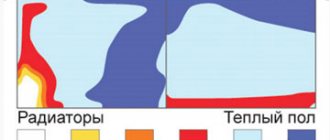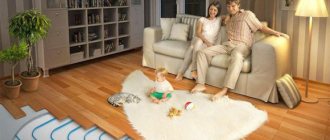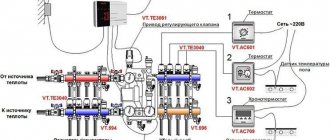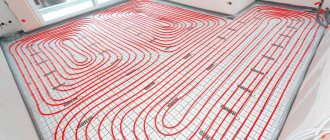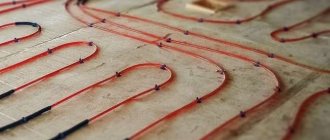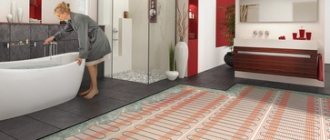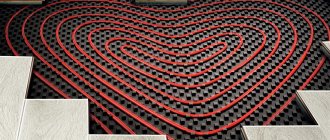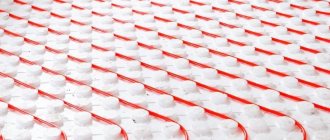Warm floors are currently a topical product, which every month is increasingly used to create cozy homes. It should be noted that warm floors are often not such a cheap pleasure for the owners, but they still buy these products. Thanks to the small layer present at the floor level, we get the warmth and comfort of the house, even if there is fierce frost and icy wind outside the window.
In addition, recently, thermal insulation mats have been increasingly used, with the help of which the same temperature regime is present in the room, which is most suitable for living. Often, such thermal insulation, as well as warm floors, are used in private houses, but apartments that are modest in size have too little space for arranging all the necessary resources.
In this article, we will understand the features of thermal insulation mats, as well as the use of warm floors within the home. In addition, we will analyze all the features of floor insulation, as well as the problems that specialists and amateurs usually face in such repair processes.
Appointment of mats
Thermal insulation mats (also called slabs) are the main component of the efficient operation of underfloor heating, and it would be foolish to dispute their necessity. After all, if this layer is not there, then the heat generated by the floor will go away (moreover, in large volumes) for heating the overlapping slabs, which is hardly advisable. The mats prevent heat energy from leaving "nowhere", therefore special requirements are imposed on them. They must withstand the weight of the pipeline with water, concrete screed, final coating and all kinds of loads that arise during operation. For this reason, the density of the heat insulator must be at least 35 kilograms per cubic meter.
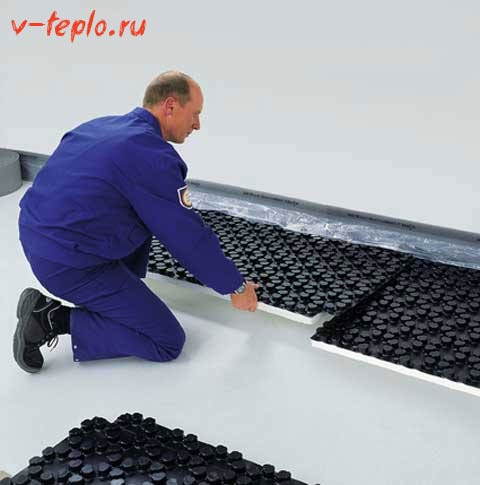
The waterproofing layer, which is laid under the mats, has the following functions:
- protection of insulation from the negative effects of the screed;
- ensuring the reliability of the floor covering, its safety for neighbors below.
Note! If the installation was carried out correctly, then it will additionally soundproof the apartment!
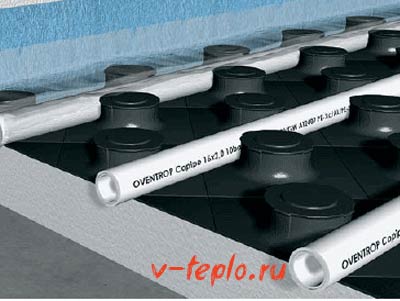

Benefits of using mats
When installed correctly, the mat can be an excellent soundproofing material. But there is a significant nuance - water floor heating must be absolutely safe for those who live below... Therefore, along with reliability and durability, such a criterion as waterproofing is valued. And the same layer is designed to protect the substrate itself from the destructive effects of the floor cement mortar.
There is an unprofessional opinion, supporters of which talk about the possibility of abandoning mats when laying floors. But this position is erroneous, since the heat losses will be so great that they will inevitably lead to significant financial losses.
If we consider the cost of all water floor systems as a whole, then the price of heaters is not so high. BUT the design, made once and in the mind - will pay off one hundred percent during operation.
Characteristics of expanded polystyrene used in warm floors
Below are the main parameters that this material should have.
- Density of about 40 kilograms per cubic meter, in order to be resistant to any kind of mechanical stress.
- Insignificant thermal conductivity (no more than 0.05 W / m * K), providing a minimum amount of heat loss.
- Due to its cellular structure and physical properties, the foam provides excellent sound insulation.
- The material is protected from the harmful effects of moisture not only by a laminated coating, but also by centering locks, which are located at the ends of the panels. And thanks to the excellent adhesion of the mats, the possibility of gaps and crevices at the joints is practically zero.
- Finally, mats can be different in size - 60x80 centimeters and 100x100 centimeters. Therefore, the installation step is also different.
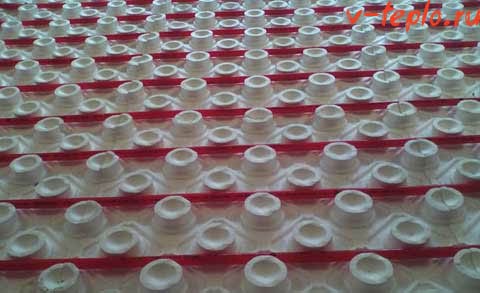

How to make a warm water floor with your own hands
We advise you to look at our instructions on how to install a warm water floor on your own. All details are here
Features of thermal insulation of a warm floor
First of all, when we thought about installing a floor heating system, we should analyze the effectiveness of its functioning. We have already said that without ensuring the required level of efficiency, we will get a rather unfavorable situation in which too much energy will be used, and there will also be no positive effect from the use of underfloor heating.
At the same time, hundreds of manufacturers around the world offer thermal insulation products that, together with a warm floor, will demonstrate the highest level of comfort and coziness. Such thermal insulation materials can have various shapes and characteristics, but the most important thing in this situation is high thermal insulation properties.
The main advantages of mats for a warm water floor
- First of all, they fully comply with all European standards. In the manufacturing process, for example, self-extinguishing raw materials are used.
- On top of the material, it is possible to lay both semi-dry and wet screeds.
- Due to the increased density of the material, excellent strength characteristics are achieved, therefore, over time mats for water floor heating do not change sizes.
- Installation of the heating pipeline is carried out according to the markings, which are applied to the surface in a special way. This contributes to a more efficient distribution of heat energy in the room.
- The mats are equipped with special clamps that allow quick installation of the pipeline.
- There are excellent physical and operational properties.
- Good thermal and sound insulation.
- Such mats are fireproof and harmless to the body.
- They withstand and do not allow moisture to pass through, without swelling.
- Self-centering locks make it easy to assemble slabs.
- The mats are resistant to decay and harmful bacteria.
- Finally, they are able to withstand temperatures from minus 180 C to plus 180 C.
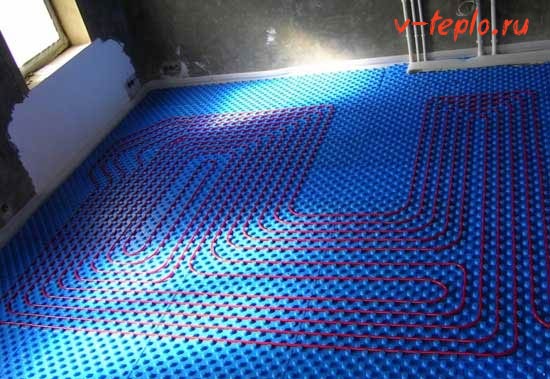

Thermal insulation boards with lamination
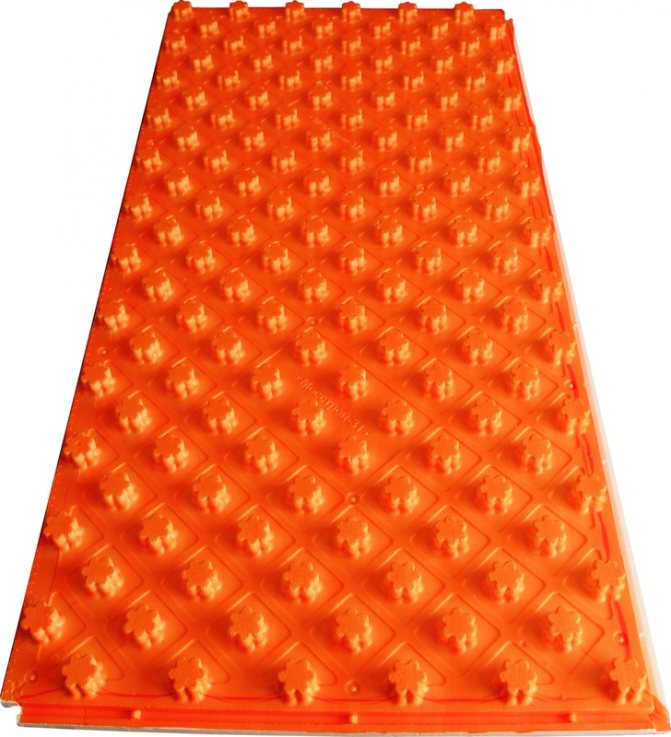

I am pleased to inform you that now we have begun to produce Underfloor heating with a laminating layer WF-22L, WF-50L with an insulating layer thickness of 22 and 50 mm.
Lamination is a polystyrene-polyethylene (PS / PE) film that is applied to a standard panel (WF). This gives additional strength to the substrate and is an excellent waterproofing.
You can find out the details by phone 8 (800) 700-31-01
(call within Russia is free) or
8 (495) 797-31-31
.
Stages of underfloor heating installation (Installation supervision) .pdf
(PDF, 70KB)
Classification of expanded polystyrene mats
The products described in this article can be:
- foil;
- with film;
- flat;
- with "bosses";
- profile.
Let's get acquainted with each of the options in more detail.
Option number 1. Foil
These mats are made of foam foam and have a special foil coating on one side. Due to their technical characteristics, they can only be used for floors that are used as an auxiliary heat source. But if you use them, say, for the floor of the first floor, under which the basement is located, then their effectiveness will be insignificant.
The pipeline is laid on the foil-coated surface of the mats, while special fixing accessories are used for fixing - clamps, brackets, steel mesh, etc. And this, of course, comes with some inconveniences.
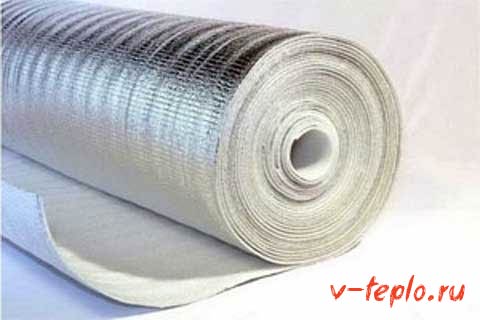

Option number 2. With film
Such boards include a foil and polystyrene foam layer, as well as a protective film. This insulation material has a high density - about 32-35 kilograms per cubic meter. To make the installation of pipes as easy as possible, special markings are made on the film.
Due to the excellent tightness, the fastening brackets that fix the pipeline are attached as securely as possible. And unlike the option described above, these mats can be used for a warm floor, which serves as an additional source of heating.
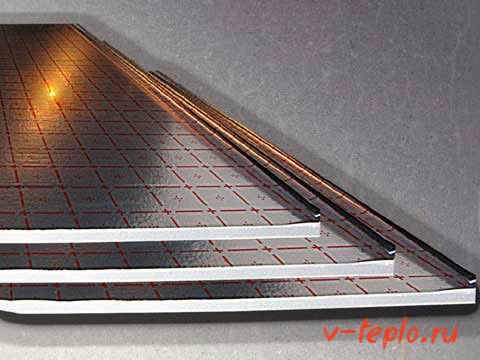

Option number 3. Flat mats
These expanded polystyrene products have a thickness of 0.4-0.5 centimeters and a density of approximately 40 kilograms per cubic meter. They are characterized by resistance to loads and deformations. The pipes are fixed with special plastic brackets. It is characteristic that before the start of installation work, markings are applied to flat plates, which makes the installation procedure somewhat more complicated.
Option number 4. Flat slabs with "bosses"
In their manufacture, a special technology of hydropellant stamping is used, as a result of which even rows of figured protrusions appear on the surface of the material (it is they who are called by this strange word "bosses"). This is one of the most modern designs that allows you to easily install the underfloor heating pipeline.
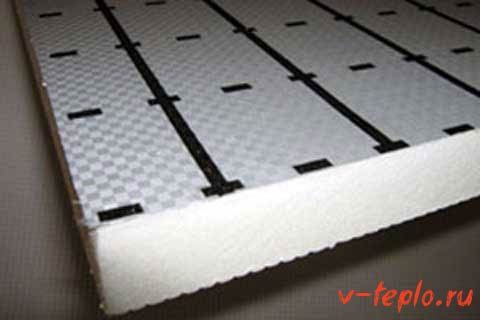

Option number 5. Profile mats
The profile products are based on rectangular polystyrene foam plates. Along the entire surface of these slabs, there are special cylindrical protrusions, the height of which is about 2.5 centimeters. And this is quite enough to place a heating pipeline between them (its diameter usually does not exceed 2 centimeters) and practically reduce to zero the possibility of pipes shifting during the pouring of a cement screed. The mats themselves are 1-3.5 centimeters thick. It is characteristic that if a warm floor is equipped on the basement floor or on the ground, then the plates of the insulating material should be wide.
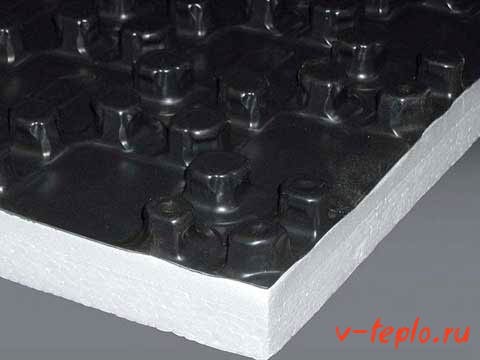

Other features of the insulation
Mats for a warm water floor are made of two types:
- laminated (that is, covered with a vapor barrier film);
- not laminated.
How to insulate the floor in a wooden house?
We advise you to look at our instructions for floor insulation in a wooden house, you can find out more here
The first option differs in that it does not require additional laying of the vapor barrier.
Note! Also note that a warm floor cannot be installed over such a base if the diameter of the latter is non-standard.
At the ends of the slabs are equipped with special locks. The ruler, which is applied, simplifies the adjustment of the mats to one another, and this, in combination with the locks, creates a continuous insulating field without any thermoacoustic seams. Consequently, heat loss is excluded in principle.
As for the thickness of the slabs, it is selected in accordance with the thickness of the topcoat and cement screed. The possibility of the presence of an insulating layer in the floor itself is also taken into account. And if its thickness is sufficient, then you can restrict yourself to mats with "bosses", which are not intended for thermal insulation, but for reliable fastening of the pipeline. Also, as noted above, not only the laminated coating protects from the negative effects of moisture, but also the centering locks located at the ends of the plates. And thanks to the excellent adhesion of the mats, the possibility of heat loss is excluded.
Video - Thermal insulation boards made of expanded polystyrene
Features of floor insulation
First of all, it must be said that warm surfaces are an essential part of modern private homes.Nowadays, people with good monetary incomes boldly install warm floors throughout the entire area of the house. Obviously, this is a reasonable investment, since coziness and comfort in the house are the most important things, without which it is simply impossible to get the maximum pleasure from staying in a spacious home.
Separately, I would like to note that in the case of a limited budget, there is simply no need to install a full-fledged underfloor heating system throughout the house. It is sufficient to cover all areas that can be used for walking barefoot. This is, first of all, a bathroom and a bedroom. Warm floors are often installed under the tiles and in the kitchen, but it is worth remembering that in warm seasons, ceramics can create not very pleasant sensations for the feet.
Indeed, floor insulation is not a cheap pleasure, therefore, the location of this system should be taken as seriously as possible.
At the same time, when planning the creation of a warm floor, you need to take care of a certain efficiency in the use of all purchased resources. For example, in the event that we have purchased a high-quality heating system, it is required to insulate the walls so that the heat does not leave the premises.
The situation is approximately the same with floor insulation. We need to do everything to ensure that heat is most efficiently used within a given space. It should be borne in mind that this means not only increasing the comfort in the house, but also doing everything possible so that resources are spent most efficiently. For example, with low thermal insulation in a house, it will be necessary to maintain a high temperature of the underfloor heating system all the time. This, in turn, means not only wear and tear of equipment, but also a considerable consumption of electricity. With the proper level of thermal insulation, we are able to save on this. It will be enough just to warm up the surface a little to feel the required level of comfort.
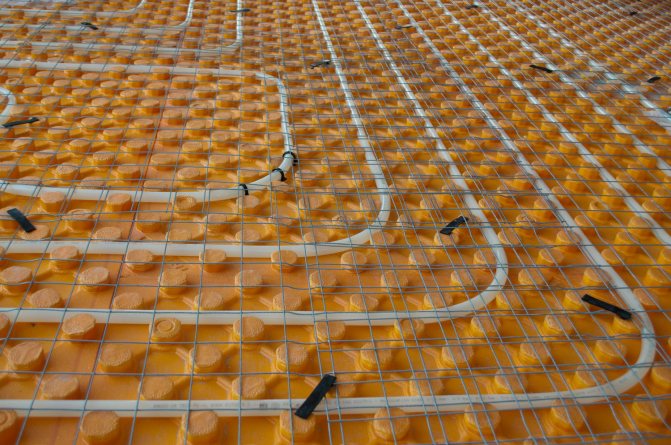

Leading manufacturers and average cost
Despite the large assortment, we advise you to pay your attention to well-known (read: proven) manufacturers who have already managed to prove themselves well on the market. Let's consider the most popular models.
Oventrop
German company engaged in the production of polystyrene foam mats. Below are the most common models.
- NP-35 - mats with "bosses", which have excellent sound and thermal insulation qualities. One side of them is covered with a polystyrene film. They are used not only with a conventional screed, but also with self-leveling floors. The average cost is about 950 rubles.
- WLG-045 - roll-type slabs covered with polypropylene film. Suitable for pipes with a diameter of 1.4 and 1.6 centimeters, as well as for a laying step within 5-30 centimeters. The area of one roll is 10 square meters, the approximate cost is 5000-5700 rubles.
- NP brand products do not have thermal insulation and will cost about 665 rubles.
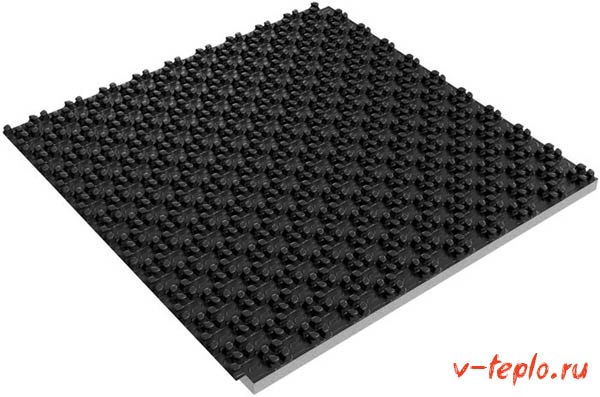

Energoflex
Domestic company producing quality products. Consider popular models.
- Energoflex TP. Foil polystyrene foam plates, on the surface of which a coordinate grid is applied with a step of 50 millimeters. Dimensions: 2.5x100x500 centimeters, the average market price is up to 250 rubles.
- "Expanded polystyrene plate". It has two-centimeter "bosses" that allow you to lay pipes without additional fasteners. There are self-centering locks, markings are applied. It fits in 5 centimeters increments and is designed for pipes with a diameter of 1.6-1.8 centimeters. Price - up to 680 rubles.
- Energoflex Super TP. Rolled mats for warm water floors. Foiled, applied with a coordination grid with a step of 5 centimeters. Dimensions: 0.5x120x150 centimeters. They cost about 250 rubles.
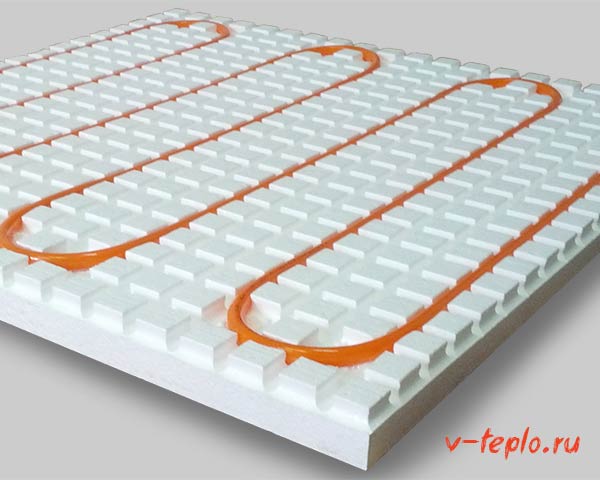

REHAU
A well-known company from Germany, which also produces expanded polystyrene insulation boards.The products are equipped with clamps for fastening the pipeline, have a sound and thermal insulation layer made of expanded polystyrene. The thickness is 3 centimeters. The average market value is 725 rubles.
How to choose the right model? First of all, the diameter of the pipes is taken into account, as well as the thickness of the insulating layers. If ceramic tiles will be laid on top of a warm floor, then the plates should be thin. By the way, it is ceramic tiles that are considered the ideal material for covering a heating water floor, since they are durable, perfectly conducts heat, and are resistant to temperature extremes and mechanical stress.
Features of installation of expanded polystyrene plates
Before proceeding with the installation of insulating mats, it is necessary to carry out several preparatory measures. The most important of them is the calculation of the heating power, which is measured in watts per square meter, as well as the area that the material should occupy. After that, you should decide on the installation diagram of the pipeline. There are several such schemes:
- spiral - it is advisable in rooms with a small area;
- double helix - used in large rooms;
- "Snake" - underfloor heating pipes are installed parallel to each other.


Note! If under the room there is an unheated or basement room and the floor, as a result, plays the role of a source of cold, then it should be insulated. For this purpose, you can use any thermal insulation material - expanded clay, mineral wool or, say, polystyrene. But it is characteristic that before installing the slabs, it is imperative to perform a screed and level it with the help of special mixtures.
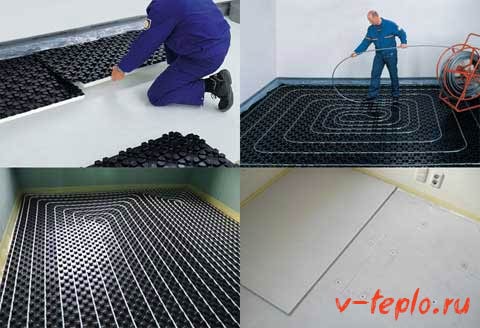

Having laid the pipes, you can start checking the system's performance - run the coolant into the pipeline, check the temperature and the presence of "cold" places. It is recommended to do this at extremely high temperatures, and also to check if the properties of the mats have changed. If everything is normal, then fill in the finishing screed.
Video - Installing a warm floor
The main advantages and disadvantages of underfloor heating
As an example, we will use the most common modifications of water-heated floors. These products are being improved all the time, however, it is unlikely that significant differences between the available copies on the market can be found.
Thus, the advantages of this warm floor are as follows:
- Savings on heating fluids. Experience shows that with the help of underfloor heating, you can significantly save on basic heating, and in some cases the benefit is about 60%. Of course, everything depends on the specific space and the characteristics of the thermal insulation of the home, therefore, before proceeding with the arrangement of the warm floor, everything must be calculated. Often this is done by specialists who supply these very warm floors. If the savings on the main sources of heating are really significant, then it is really advisable to install a warm floor.
- Comfort. With the help of a warm floor, comfort is created even if we have too large and poorly heated space. Walking barefoot on the warm floor in the cool season is a real pleasure. The most important thing to keep in mind is that this installation provides uniform floor heating. Even at low operating temperatures of the underfloor heating, we get a sufficient level of comfort. Manufacturers indicate that + 18 ° is enough for the feet.
- Safety of use. The warm floor is reliably hidden under a certain covering. In this way, we can be confident in the high safety of the installation. Children will not be able to affect the performance of the installation in any way, and in case of malfunctions, you can simply disconnect the warm floor from the power source.Often, the settings set the most acceptable temperature for the feet, which will never leave burn marks even on the delicate children's skin. In most cases, specialists involved in the installation of underfloor heating carry out a comprehensive analysis of the operation of the installation, and only after it becomes clear that there are no problems, they are allowed to fully operate.
Disadvantages of underfloor heating:
- Complexity of installation. The process of installing a warm floor is really not as simple as it might seem, so most owners involve specialists in this matter. The installation itself is quite expensive, therefore, if serious problems arise with your own installation, you will not be able to avoid large monetary losses. Thus, it is better to spend extra money, but be sure of the high quality of the work carried out.
- Leaking pipeline. As you know, the water system of underfloor heating consists of small diameter pipes. Through these very pipes, warm water is launched, which heats the floor. In the event that for some reason a leak occurs, you will have to completely dismantle the floor covering (and this can be laminate or even ceramic tiles). This is an extremely demanding process that can lead to serious problems and inconveniences.
- Low efficiency. Sometimes it turns out that the owners who decide to install a full-fledged warm floor believe that this system will be the main heating equipment in the house. Of course, a warm floor cannot provide complete comfort, therefore it is advisable to use other systems in parallel. Despite this, some experts responsibly argue that a warm floor may well be the main heating system, but for this you need to insulate the floor, walls, ceiling, and also ensure excellent sealing of door and window openings. It is extremely difficult to achieve such a result, since for comprehensive insulation and sealing you will have to spend colossal money and a lot of effort, so it is more expedient to take care of installing a full-fledged heating.
Thus, if you analyze all the information provided, it becomes clear that underfloor heating systems are not the most unambiguous solution for installation in the house. Accordingly, if we have a modest house and a limited budget, installing a warm floor is a serious risk.
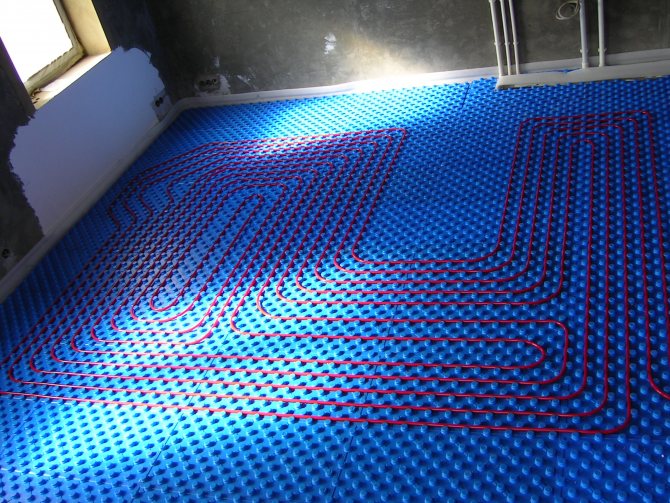

Mat selection criteria
- As already noted, attention should be paid only to well-known manufacturers, because in their factories the quality is strictly controlled to maintain the brand. Therefore, the percentage of rejects is minimal.
- Price.
- The specific type of mat depends on the area of the room in which the heating cable is planned to be laid. And if the area is large, then you should give preference to products with "lugs".
- Thermal insulation properties, depending on the density of the material and the thickness of the insulation.
- Additional installation fittings. This includes elements designed to connect plates, as well as insulation for joints.
If you focus on this, you will find the model that is ideal for your situation.
Summing up
Mats for a warm water floor are a material that cannot be economized in any way. Their quality affects not only the efficiency of the heating system, but also the likelihood of emergencies. That's all, warm winters to you!
Styling
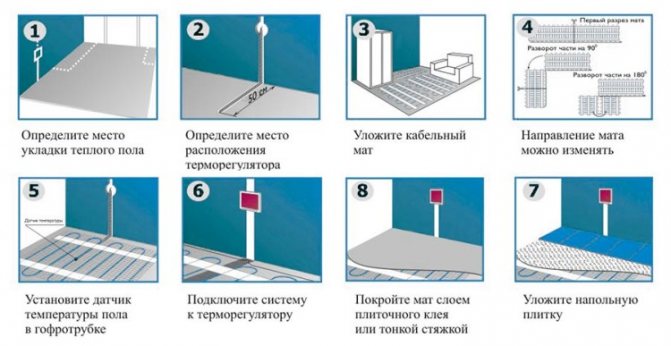

- All parts must be connected to each other.... And under the sheets, regardless of their type, there must be a backing made of a waterproofing film;
- Along the perimeter of the floor at the edge of the wall the waterproofing film is fixed using a damper tape;
- Slabs are laid on top of the waterproofing, mats for a water underfloor heating made of foam board must be fastened with the help of locking mechanisms provided at the ends.If the weight and thickness of the insulation allow, then the plates can be additionally fixed with glue;
- It is strictly forbidden to use nails for fastening and so on, since this violates the integrity of the product and greatly reduces its strength;
- Smooth plates without provided fasteners are stacked very tightly and seated on an adhesive "pillow". Foil products are taped to achieve complete tightness;
- Once the sheets are secured - start marking and lay the water circuit;
- The final stage - finishing coat for warm water floor.

